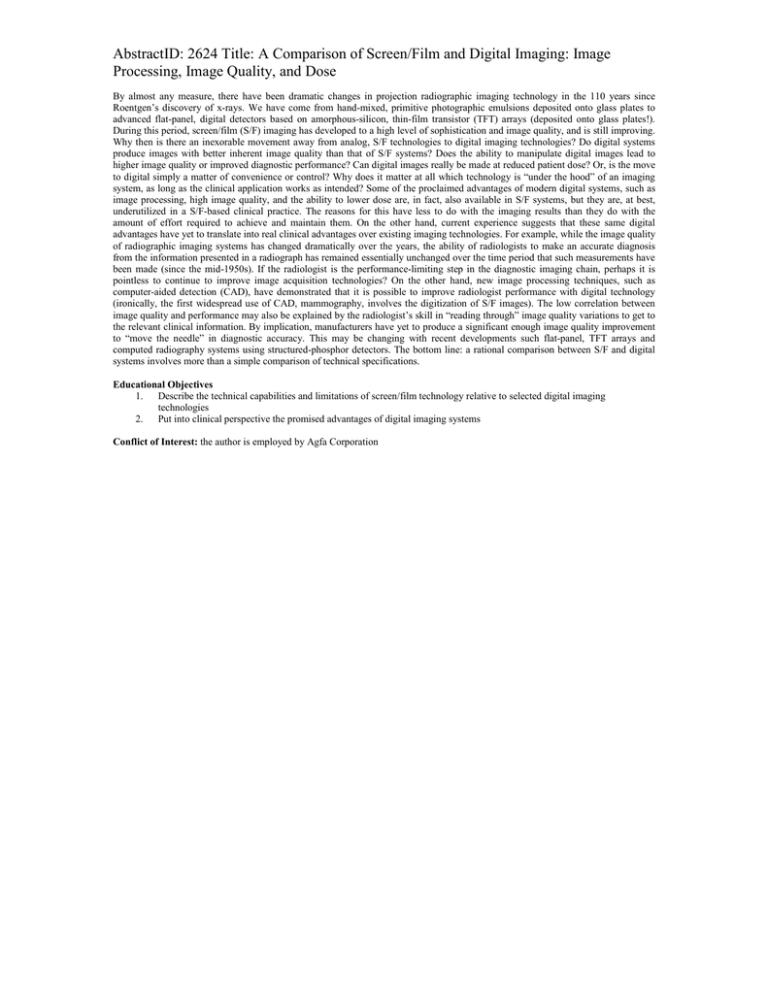AbstractID: 2624 Title: A Comparison of Screen/Film and Digital Imaging:... Processing, Image Quality, and Dose
advertisement

AbstractID: 2624 Title: A Comparison of Screen/Film and Digital Imaging: Image Processing, Image Quality, and Dose By almost any measure, there have been dramatic changes in projection radiographic imaging technology in the 110 years since Roentgen’s discovery of x-rays. We have come from hand-mixed, primitive photographic emulsions deposited onto glass plates to advanced flat-panel, digital detectors based on amorphous-silicon, thin-film transistor (TFT) arrays (deposited onto glass plates!). During this period, screen/film (S/F) imaging has developed to a high level of sophistication and image quality, and is still improving. Why then is there an inexorable movement away from analog, S/F technologies to digital imaging technologies? Do digital systems produce images with better inherent image quality than that of S/F systems? Does the ability to manipulate digital images lead to higher image quality or improved diagnostic performance? Can digital images really be made at reduced patient dose? Or, is the move to digital simply a matter of convenience or control? Why does it matter at all which technology is “under the hood” of an imaging system, as long as the clinical application works as intended? Some of the proclaimed advantages of modern digital systems, such as image processing, high image quality, and the ability to lower dose are, in fact, also available in S/F systems, but they are, at best, underutilized in a S/F-based clinical practice. The reasons for this have less to do with the imaging results than they do with the amount of effort required to achieve and maintain them. On the other hand, current experience suggests that these same digital advantages have yet to translate into real clinical advantages over existing imaging technologies. For example, while the image quality of radiographic imaging systems has changed dramatically over the years, the ability of radiologists to make an accurate diagnosis from the information presented in a radiograph has remained essentially unchanged over the time period that such measurements have been made (since the mid-1950s). If the radiologist is the performance-limiting step in the diagnostic imaging chain, perhaps it is pointless to continue to improve image acquisition technologies? On the other hand, new image processing techniques, such as computer-aided detection (CAD), have demonstrated that it is possible to improve radiologist performance with digital technology (ironically, the first widespread use of CAD, mammography, involves the digitization of S/F images). The low correlation between image quality and performance may also be explained by the radiologist’s skill in “reading through” image quality variations to get to the relevant clinical information. By implication, manufacturers have yet to produce a significant enough image quality improvement to “move the needle” in diagnostic accuracy. This may be changing with recent developments such flat-panel, TFT arrays and computed radiography systems using structured-phosphor detectors. The bottom line: a rational comparison between S/F and digital systems involves more than a simple comparison of technical specifications. Educational Objectives 1. Describe the technical capabilities and limitations of screen/film technology relative to selected digital imaging technologies 2. Put into clinical perspective the promised advantages of digital imaging systems Conflict of Interest: the author is employed by Agfa Corporation






